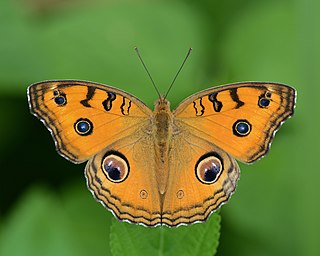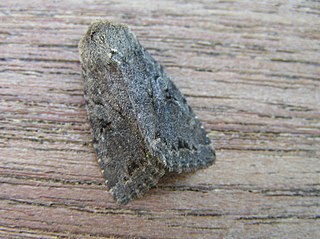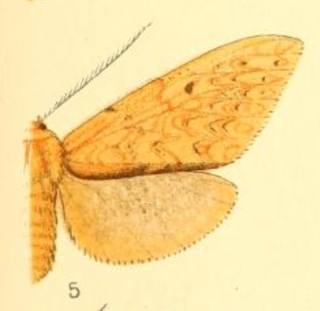
The garden dart is a moth of the family Noctuidae. It is distributed throughout much of the Palearctic. Temperate regions of Europe, Central Asia and North Asia, as well as the mountains of North Africa. Absent from polar regions, on Iceland and some Mediterranean islands, as well as in Macaronesia.

The brown hairstreak is a butterfly in the family Lycaenidae. The range includes most of the Palaearctic.

Apamea crenata, known as the clouded-bordered brindle, is a moth in the family Noctuidae. It is distributed throughout the Palearctic realm. In the North it crosses the Arctic Circle, in the Mediterranean it is found only in cool locations and mountains avoiding very hot areas. In the Alps, it rises to an altitude of about 2000 metres.

Azanus ubaldus, the bright babul blue, desert babul blue, or velvet-spotted blue, is a small butterfly found in India, the Middle East and Africa that belongs to the lycaenids or blues family.

Petrelaea dana, the dingy lineblue, is a species of lycaenid butterfly found in Indomalayan realm.

Junonia almana, the peacock pansy, is a species of nymphalid butterfly found in Cambodia and South Asia. It exists in two distinct adult forms, which differ chiefly in the patterns on the underside of the wings; the dry-season form has few markings, while the wet-season form has additional eyespots and lines.It is listed as Least Concern in the IUCN Red List.

Hippotion celerio, the vine hawk-moth or silver-striped hawk-moth, is a moth of the family Sphingidae. It was described by Carl Linnaeus in his 1758 10th edition of Systema Naturae.

Vagrans is monotypic genus with the species vagrant a species of nymphalid butterfly found in forested areas of tropical South Asia and Southeast Asia.

Nymphalis xanthomelas, the scarce tortoiseshell, is a species of nymphalid butterfly found in eastern Europe and Asia. This butterfly is also referred as yellow-legged tortoiseshell or large tortoiseshell.

Hypena proboscidalis, the snout, is a moth of the family Erebidae. The species was first described by Carl Linnaeus in his 1758 10th edition of Systema Naturae.

Fissipunctia ypsillon, the dingy shears, is a species of moth of the family Noctuidae. It is found in the Palearctic realm.

Mesapamea secalis, the common rustic, is a moth of the family Noctuidae. The species was first described by Carl Linnaeus in his 1758 10th edition of Systema Naturae. It is found in Europe, north-west Africa, Turkey and northern Iran.

Xylophanes libya, the Libya sphinx, is a moth of the family Sphingidae. The species was first described by Herbert Druce in 1878. It is known from southern Texas, Mexico, Belize, Guatemala, Panama and from Venezuela south and west to Bolivia and Paraguay.

Aegle semicana is a moth of the family Noctuidae. It was described by Eugenius Johann Christoph Esper in 1798. It is found in Austria, Italy, Hungary, former Yugoslavia, Romania, Bulgaria, Albania, Greece, Turkey, Russia, Libya, Egypt, Syria, Iraq, Iran and Israel, as well as on Sardinia, Sicily, Malta and Cyprus.

Lophocampa margona is a moth of the family Erebidae. It was described by William Schaus in 1896. It is found in Mexico.
Givira tristani is a moth in the family Cossidae. It is found in Colombia, Guatemala, Honduras and Mexico.
Friseria cockerelli, the mesquite webworm moth, is a moth of the family Gelechiidae. It is found in Mexico and the southern United States, where it has been recorded from Texas, New Mexico, Arizona, Colorado, California, Oklahoma and Nevada.
Scopifera antorides is a species of moth in the family Erebidae. It was described by Herbert Druce in 1891. It is found in Guatemala, Costa Rica and in Mexico in Durango and Xalapa.
Megalopyge radiata is a moth of the Megalopygidae family. It was described by Schaus in 1892. It is found in Mexico and Brazil.
Macronoctua onusta, the iris borer, is a species of cutworm or dart moth in the family Noctuidae. It is found in North America.














